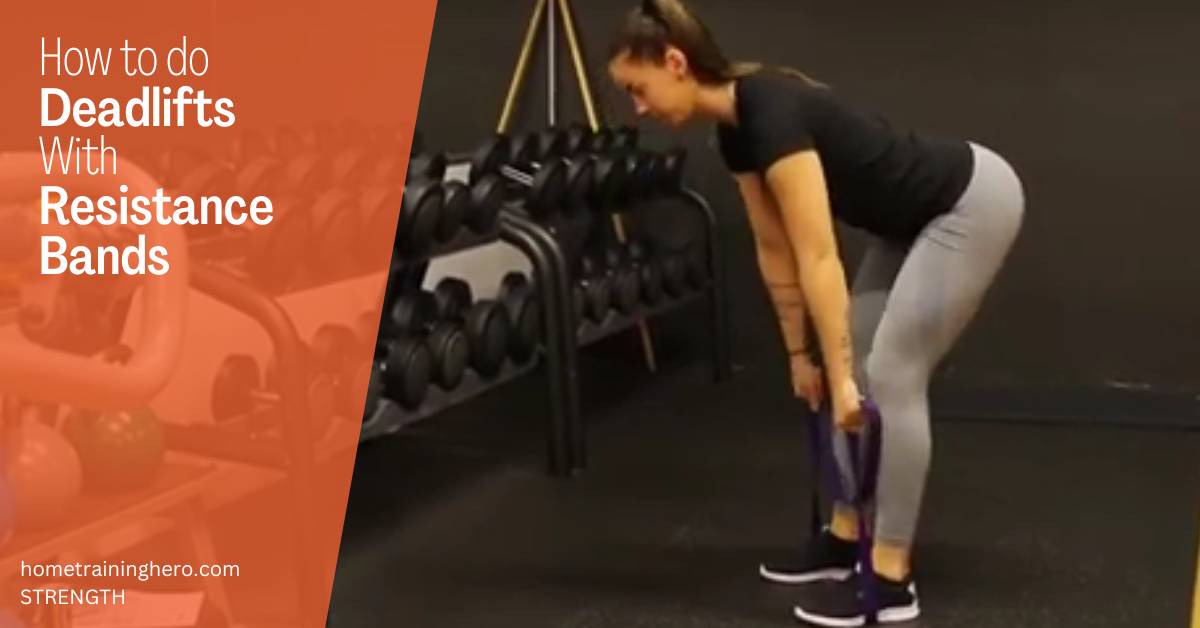Deadlifts are a popular and effective exercise for building strength in the lower body – particularly the glutes, hamstrings, and quads. While traditional deadlifts involve lifting a barbell loaded with weights, there’s an alternative way to perform this exercise – just as effective.
Meet resistance band deadlifts.
Resistance bands provide constant tension throughout the movement, which helps develop muscle stability and enhances the effectiveness of the exercise. In this guide, we will show you how to do deadlifts with resistance bands – and also explain why doing deadlifts this way can bring your back routine to new levels.
Contents
The Mechanics of Deadlifts with Resistance Bands
The mechanics of deadlifts with resistance bands are similar to those of traditional deadlifts. However, the addition of resistance bands introduces a new element of challenge and muscle activation.
When you attach resistance bands to a barbell, the bands stretch as you lift the weight, creating more tension and making your muscles work harder throughout the entire range of motion.
As a result, deadlifts with resistance bands engage your muscles more effectively, leading to greater gains in strength and muscle mass.
The Benefits of Deadlifts with Resistance Bands
Deadlifts with resistance bands offer several unique advantages over traditional deadlifts. Let’s take a closer look at some of these benefits:
Increased Muscle Activation
The use of resistance bands places continuous tension on your muscles, ensuring constant engagement throughout the movement. This increased muscle activation leads to greater strength gains and improved muscular development.
Enhanced Stability and Core Strength
Due to the tension created by resistance bands, deadlifts with resistance bands require more core stabilization. This helps strengthen your core muscles and improve overall stability, benefiting not only your deadlifts but also other compound movements.
Reduced Joint Strain
The tension provided by resistance bands helps to reduce the strain on your joints during the eccentric (lowering) phase of the exercise. This makes deadlifts with resistance bands a safer option for individuals with joint issues or previous injuries.
Versatility and Portability
Resistance bands are lightweight, compact, and easy to carry. You can perform deadlifts with resistance bands anywhere, whether you’re at home, in the gym, or even while traveling. This versatility allows you to maintain your workout routine regardless of your location.
Getting Started: How to Do Deadlifts with Resistance Bands
Starting with deadlifts using resistance bands is an effective way to enhance your strength and stability. Let’s break down the step-by-step process to help you perfect this exercise and enjoy its benefits:
- Attach the Resistance Bands: First, secure the resistance bands to an anchor point or a stable surface. Make sure they are fastened securely and evenly on both sides of the anchor point.
- Position Yourself: Stand with your feet about shoulder-width apart, toes pointing slightly outward. The resistance bands should be positioned under the arches of your feet.
- Grip the Bands: Bend at your hips and knees while reaching down to grasp the resistance bands. Your hands should be positioned just outside of your knees, creating tension in the bands.
- Engage Your Core: Before lifting, engage your core muscles by drawing your belly button in towards your spine. This bracing action is essential for protecting your lower back during the exercise.
- Lift the Bands: Begin the lift by straightening your hips and knees while maintaining a straight back. As you do this, pull the resistance bands upwards. Keep the bands close to your body throughout the movement.
- Stand Upright: Once you’ve reached a fully upright position, pause briefly and contract your glutes. Ensure you maintain tension in the resistance bands and keep your spine in a neutral position.
- Lower the Bands: Slowly reverse the movement by bending at your hips and knees, lowering the resistance bands back to the starting position. Maintain control and tension in the bands as you do so.
- Repeat: Perform the desired number of repetitions, ensuring that each repetition is controlled and deliberate.
Progressing with Deadlifts and Resistance Bands
As with any exercise, it’s important to gradually progress to avoid plateauing and maximize your results. Here are some tips to help you progress with deadlifts using resistance bands:
- Increase Band Resistance: As you become stronger, gradually increase the tension of the resistance bands. This can be achieved by using thicker bands or adding more bands to the barbell.
- Focus on Form: Proper form is crucial for maximizing the benefits of deadlifts and minimizing the risk of injury. Pay close attention to your technique and seek guidance from a qualified trainer if needed.
- Vary Your Rep Range: To continuously challenge your muscles, incorporate different rep ranges into your training. This can help stimulate muscle growth and prevent adaptation.
Final Words
Deadlifts with resistance bands offer a highly effective alternative to traditional deadlifts.
By incorporating resistance bands, you can enhance muscle activation, improve stability, and experience the benefits of this compound exercise in a new way.
Remember to start with proper form, progress gradually, and listen to your body throughout your journey of mastering deadlifts with resistance bands.
Happy lifting!
Other Helpful Resources
- Understanding the Different Resistance Bands Strength Levels by Color
- Achieving Bodybuilding Goals with Resistance Bands Only: A Complete Guide
- Why Resistance Bands are Better Than Weights: 5 Reasons to Add Resistance Bands to Your Workout Routine
- What Type of Resistance Bands Should I Buy? The Ultimate Guide to Choosing the Right Resistance Bands
- Are Resistance Bands Good for Building Muscle? Science And Facts




